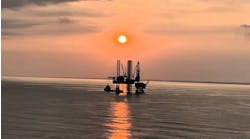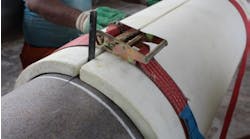Jeremy Beckman • London
Sverdrup process jacket shipped out
Kvaerner has delivered its third jacket for Equinor’s Johan Sverdrup Phase 1 project in the Norwegian North Sea. The process platform jackets sailed last month from the company’s yard in Verdal, western Norway: according to Kvaerner, the deliveries from Verdal represent around 90% of the total substructure weight for the four-platform complex and involved fabricating almost 100,000 metric tons (110,231 tons) of steel. Kvaerner also claimed that following cost reduction measures designed specifically for this project, it can now manufacture new jackets at a lower price than was possible in 2005.
Tolmount, Buzzard II going forward
Premier Oil and Nexen have committed to greenfield and expansion projects in the UK North Sea, and a further development is in prospect following Neptune Energy’s asset deal for the Seagull discovery.
Tolmount, in the southern North Sea, is one of the UK’s largest undeveloped gas fields with estimated resources of 500 bcf recoverable. Premier, as operator, has entered an innovative arrangement under which it will pay $120 million for its share of capex for the development, related to project management and drilling of the wells. Dana Petroleum, its 50-50 partner in the field, will co-own and co-finance construction of the minimal facilities platform, installation of the subsea pipeline, and upgrades to Centrica’s Easington reception terminal on the Lincolnshire coast, under a joint venture with CATS Management subsidiary Humber Gathering System Ltd. Rosetti Marino will construct the platform and Saipem the pipeline system. Premier anticipates start-up in late 2020, with peak production of up to 300 MMcf/d.
Nexen Petroleum UK and its partners have sanctioned a new phase of development at the Buzzard oil field in the UK central North Sea, focused on reserves 5 km (3.1 mi) northeast of the field’s production complex. Following completion of front-end engineering design in June, an integrated team of five main contractors is collaborating on the program at Nexen’s offices, under an incentivized, outcome-based commercial model.
Buzzard Phase II will involve a subsea tieback to the existing production platform, with the facilities comprising a 12-slot manifold (eight slots for new producer wells, four for water injectors) connected to a pipeline bundle assembly incorporating pipelines, manifolds, controls and chemical injection. Baker Hughes, a GE company (BHGE), which also supplied equipment for the original Buzzard development, will provide six midwater horizontal subsea trees for production and injection, wellheads and control systems; and integrated drilling, completion and intervention services. Subsea 7 will manufacture the bundle and install the subsea kit, while COSL Drilling’s semisub COSLPioneer will start the 16-18-month drilling program next February. The other main contractors are AGR Well Management and WorleyParsons, the latter responsible for the associated topsides module on the production platform which Rosenberg WorleyParsons will fabricate in Stavanger.
Neptune Energy, the rapidly growing North Sea-focused E&P company which recently agreed to buy VNG Norge, is now pushing to develop the Seagull oil and gas field in the UK central North Sea. Pending regulatory approvals, Neptune will acquire a 35% interest from Apache in Seagull, 80 km (50 mi) south of the Forties complex, which underwent a successful extended test in 2015 of an appraisal well. Aberdeen-based Infinity is supporting pre-front-end engineering design (pre-FEED) and FEED for the proposed development, a multi-well subsea tieback to nearby facilities. Neptune expects the project to begin next year followed by first oil before 1Q 2022. •
Offshore Ireland gas complex to close
Demand looks set to intensify for specialist heavy-lift vessels and P&A services in northwest Europe, with five more operators announcing decommissioning plans of varying scale. In the Norwegian North Sea, Equinor has approval from Norway’s Petroleum Safety Authority to dispose of the Huldra field wellhead platform, which ceased operations in 2014, 13 years after start-up. Operations were controlled remotely from the Veslefrik B platform. And close to the median line with the UK, Lundin has decided to permanently shut down production from the Brynhild field, a subsea tieback to the Haewene Brim FPSO serving Shell’s Pierce field in UK waters. Continuing water capacity constraints and uptime issues at the FPSO mean that Brynhild is no longer economic to produce, Lundin said.
Petronas subsidiaries PSE Kinsale Energy and PSE Seven Heads have applied to Ireland’s government to decommission various production facilities in the Celtic Sea 40-70 km (25-43 mi) off the country’s southern coast. Marathon Oil originally developed the Kinsale Head gas field in 1978, later bringing online the Ballycotton and Seven Heads fields, and this complex had been Ireland’s sole offshore production center until Shell’s recent development of Corrib off the northwest coast. All three of the Kinsale area fields are said to be nearing the end of their productive lives: the initial application covers removal of two topsides structures, various subsea facilities, and P&A of development wells.
The Huldra platform. (Photo by Kjetil Alsvik/courtesy Equinor)
In the UK southern gas basin, ConocoPhillips is seeking permission to decommission seven fixed platforms at the Viking field complex, which started production in 1972, along with various subsea structures and interfield pipelines. The Viking and subsea Vixen satellite produced 1.7 tcf up to cessation of production in early 2016. All the gas was exported through pipelines to the Theddlethorpe terminal on the Lincolnshire coast.
Finally, Repsol Sinopec Resources has submitted a draft decommissioning program to the UK’s Department of Business, Energy and Industrial Strategy for the Beatrice field complex in the Outer Moray Firth 22 km (14 mi) offshore northeast Scotland. This covers four fixed steel jacket platforms, eight pipelines, two wind turbines, one power cable and P&A of 30 wells at the Beatrice Alpha platform. The company plans to remove and recycle all topsides and jackets and a drilling template, and to complete P&A work by 2026 – the abandonment designs will incorporate lessons learned from the 13 wells already plugged at Beatrice Bravo and Charlie.





